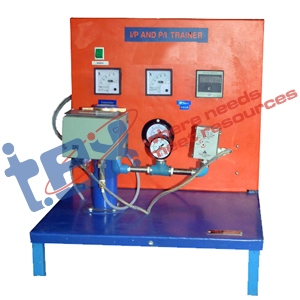

The I to P and P to I Trainer is a specialized process control educational setup designed to demonstrate the working principles of current-to-pressure (I/P) and pressure-to-current (P/I) converters. This trainer helps students understand how electrical signals are converted into pneumatic signals and vice versa — a fundamental concept in industrial automation and control systems.
Built for Engineering Colleges, ITIs, and Research Institutes, the I to P and P to I converter trainer provides practical exposure to real-time industrial instrumentation. It is ideal for training in process control, instrumentation, and automation labs, offering hands-on experience with transducers, signal conversion, and calibration techniques.
This I to P and P to I trainer kit consists of a compact and durable setup mounted on a powder-coated frame. It includes an I/P converter, P/I converter, air regulator, pressure gauges, current source, and measuring instruments to study signal conversion characteristics.
The current-to-pressure converter educational setup allows users to input a standard 4–20 mA signal, which is converted to a proportional pneumatic output (3–15 psi). Conversely, the pressure-to-current trainer converts pneumatic input pressure into a proportional electrical current signal. This dual-mode operation provides complete insight into signal transmission and feedback control in industrial automation systems.
This process control instrumentation trainer kit is designed for ease of use, safety, and repeatability, enabling students to conduct experiments on signal calibration, linearity, and system response.
| Specification | Details |
|---|---|
| Power Supply | 230V AC, 50Hz |
| I/P Converter | 4–20 mA input to 3–15 psi output |
| P/I Converter | 3–15 psi input to 4–20 mA output |
| Air Supply | Clean, dry air at 1–2 bar |
| Measuring Instruments | Pressure gauge, Current Source |
| Display | Analog/digital for current and pressure |
| Control Valves | Needle and regulator type |
| Construction | MS powder-coated frame with labeled panel |
| Safety Features | Over-pressure relief valve, insulated electrical wiring |
The I to P and P to I Trainer bridges the gap between theory and practical understanding in the field of industrial process control. Students gain exposure to the conversion process used in automation systems, helping them understand how field instruments communicate with control devices.
This trainer builds confidence in handling electro-pneumatic instruments, performing calibration and troubleshooting, and understanding loop control principles. It is an essential tool for developing technical skills required in modern industrial environments.